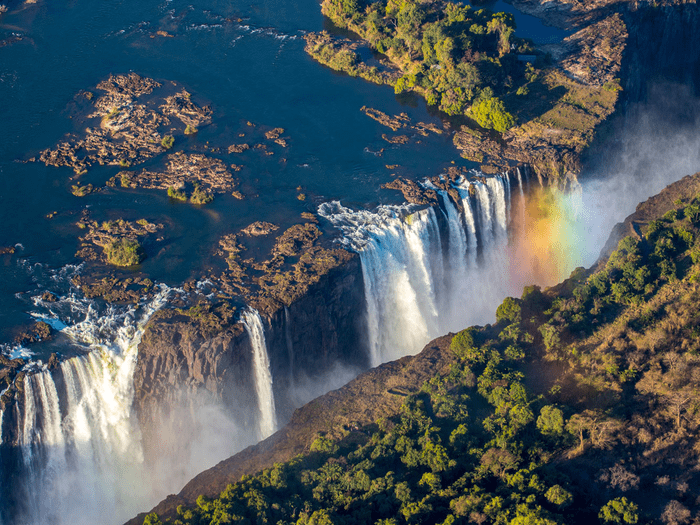This article highlights the top 10 natural wonders of the world that one should witness at least once in their lifetime. The list features stunning destinations, including Victoria Falls on the border between Zambia and Zimbabwe, the Grand Canyon in Arizona, the Great Barrier Reef off the coast of Australia, Mount Everest on the border of Nepal and Tibet, the Northern Lights, the Amazon rainforest in South America, the Great Blue Hole in Belize, the Grand Prismatic Spring in Yellowstone National Park, Uluru in the Australian Outback, and the Aurora Australis in the southern hemisphere. The post concludes by emphasizing that these natural wonders reflect the magnificence of nature that we should appreciate and preserve.
10 Natural Wonders of the World
The world is full of awe-inspiring natural wonders that leave us mesmerized with their beauty, power, and grandeur. From towering peaks to vast deserts, mysterious underwater caves to breathtaking waterfalls, these natural wonders are truly a testament to the earth’s extraordinary and diverse landscapes. Here, we list the 10 natural wonders of the world that everyone should see at least once in their lifetime.
1. Victoria Falls
Located on the border between Zambia and Zimbabwe, Victoria Falls is one of the largest waterfalls in the world. With a width of more than a mile and a height of 355 feet, the falls are a dramatic sight, with a thunderous roar that can be heard from miles away.
2. The Grand Canyon
Carved over millions of years by the Colorado River, the Grand Canyon in Arizona is a geological marvel that stretches for 277 miles, with a depth of over a mile. The canyon’s colorful rock formations, steep cliffs, and rugged terrain attract millions of visitors each year.
3. Great Barrier Reef
The Great Barrier Reef is the world’s largest coral reef system, stretching for more than 1,400 miles off the coast of Australia. Home to thousands of species of marine life and a kaleidoscope of colorful coral, the reef is a must-see destination for divers and snorkelers alike.
4. Mount Everest
Standing at a staggering 29,029 feet, Mount Everest is the tallest peak in the world, situated on the border between Nepal and Tibet. It’s an enduring symbol of human achievement, with thousands of climbers attempting to reach its summit each year.
5. The Northern Lights
The Northern Lights, also known as Aurora Borealis, are a natural light display that occurs in the polar regions, caused by the interaction between the Earth’s magnetic field and solar wind. The resulting display of vibrant colors and patterns in the night sky is a magical experience that has captivated people for centuries.
6. The Amazon Rainforest
The Amazon Rainforest is the largest tropical rainforest in the world, covering over 2.1 million square miles across nine countries in South America. It’s home to an incredible array of plant and animal life – from jaguars and macaws to thousands of species of plants – making it both a vital ecosystem and a wondrous sight to behold.
7. The Great Blue Hole
The Great Blue Hole is a massive underwater sinkhole off the coast of Belize that’s more than 410 feet deep and 1,000 feet wide. Its deep blue waters, filled with a diverse array of marine life, make it one of the most popular destinations for divers and snorkelers in the world.
8. The Grand Prismatic Spring
The Grand Prismatic Spring in Yellowstone National Park is the largest hot spring in the United States and one of the most colorful natural wonders in the world. Its vibrant hues – ranging from deep blues to bright oranges and reds – are caused by different types of bacteria that thrive in the spring’s mineral-rich waters.
9. Uluru (Ayers Rock)
Uluru, also known as Ayers Rock, is a massive sandstone rock formation located in the Australian Outback. A sacred site for the local Anangu people, Uluru is a striking monolith that changes color throughout the day, from dusky reds to fiery oranges and purples during sunrise and sunset.
10. The Aurora Australis
The Aurora Australis, also known as the Southern Lights, is the southern hemisphere’s version of the Northern Lights, occurring in the polar regions of the southern hemisphere. Its vivid display of colors and patterns is a breathtaking sight that’s best witnessed from the southern tip of New Zealand or from Antarctica.
Conclusion
Whether you’re an avid traveler or a nature enthusiast, these 10 natural wonders of the world will leave you awestruck with their beauty and grandeur. From towering peaks to vast oceans, these natural wonders are a testament to the awe-inspiring power of nature that we are fortunate enough to witness and appreciate.
